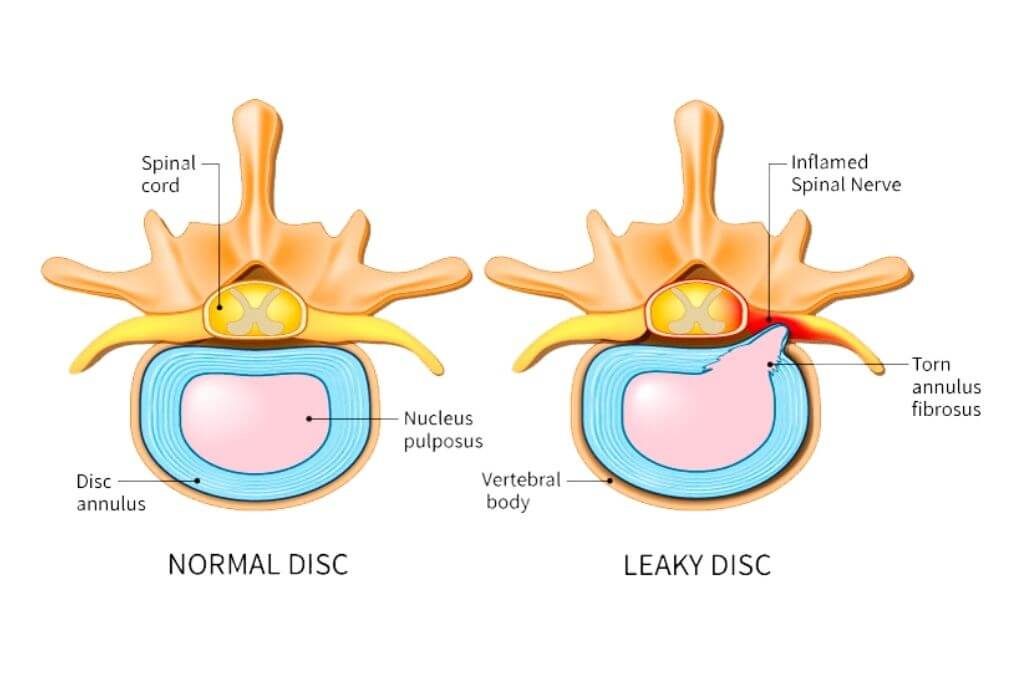Annular tear surgery is often recommended for those living with pain caused by annular tears. In addition to this, annular tears are the most common cause of many conditions, like degenerative disc disease, sciatica, herniated discs, or chronic low back pain. This is why it’s so important to understand the best way to treat annular tears.
Keep reading to learn what annular tears are, what causes them, whether annular tear surgery works and more.
What Are Annular Tears?
Before explaining annular tear surgery and what an annular tear even is, we have to discuss the anatomy of the spinal disc.
Your spinal discs are made of two parts: the annulus fibrosus and the nucleus pulposus. The annulus fibrosus is the outer portion of the disc, made of 22-25 layers of furious collagen rings. These rings encase the nucleus pulposus. The nucleus pulposus is the inner layer of your spinal discs and is a jelly-like substance that will leak if not contained by the annulus fibrosus.
In addition to containing the nucleus pulposus, the layers of the annulus fibrosus also contain sensory nerves.
The purpose of your spinal discs is to absorb shock between the vertebrae. Whenever you participate in a high-impact activity, your spine sustains trauma, or you exert or strain your back, the spinal discs absorb the impact. Although this is what they’re built to do, this stress wears your discs down over time. Over time, discs can be worn down to the point of developing tears in the annulus fibrosus, known as annular tears.
Annular tears can occur anywhere throughout your spine, but they usually develop in the neck (cervical spine) and lower back (lumbar spine) because these are the most mobile areas of the spine. Lower back issues are especially common because the lumbar spinal discs take the most stress in day-to-day activities and movements.

Types
There are three types of annular tears: transverse, radial, and concentric.
- Transverse tears reach from the outer rim to the inner layers of the annulus fibrosus. This type of tear leads to the most significant pain.
- Radial tears don’t cause as much pain as transverse tears. They usually occur in the innermost layer of the annulus fibrosus, but they can grow until they reach the outer rim.
- Concentric tears occur in the ring around the nucleus pulposus. They commonly result from torsional injuries which are caused by repetitive and excessive twisting of the spine.
Causes
Earlier in this article, we briefly mentioned some things that can cause annular tears to develop, so now we’re going to go into further detail.
The most common cause of annular tears is aging. In fact, just about every adult will have developed annular tears by the time they leave their teen years. This is because the spinal discs simply become worn down with age which leads to tearing. It may be helpful to think of the annulus fibrosus like a rubber band. A new rubber band can stretch out and easily snap back to its original size and shape but over time, or with more vigorous stretching, it will develop cracks and tears.
Certain occupations can also cause annular tears if they require heavy lifting, bending forward, or twisting. Even sitting at a desk for long periods of time can cause tears to develop because of the stress that sitting puts on the lumbar spine. High-impact sports and activities also place high stress on spinal discs and can cause tears.
Even genetics can determine your likelihood of developing annular tears. The strength and quality of the collagen that makes up the annulus fibrosis is determined by your genes. If this collagen isn’t particularly strong, your likelihood of annular tears increases.
Symptoms
As mentioned earlier, the annulus fibrosus contains the nucleus pulposus. When annular tears develop, the annulus fibrosus’s ability to contain the nucleus pulposus is affected, leading to leaking. When the nucleus pulposus leaks and comes into contact with the sensory nerves in the annulus fibrosus, it can cause irritation, inflammation, and pain in the disc. The leaking nucleus pulposus may also leak onto surrounding spinal nerve roots, irritating these nerves as well. These irritated nerves may then refer this irritation pain to the extremities, causing pain in the arms, hands, legs, and even feet. This is what Dr. Pauza calls Leaky Disc Syndrome™.
Leaking also causes the spinal discs to break down in general due to dehydration (disc desiccation), which lowers the ability of the spinal discs to continue providing flexibility for the spine.
Here’s a more complete list of symptoms caused by annular tears.
- Localized or “discogenic” pain, meaning pain in or near the torn spinal disc(s).
- Pain in the arms, legs, hands, or feet.
- Muscle weakness.
- Tingling or numbness in the limbs.
- Pain that feels worse when you sit, bend forward, lift, or twist.
- Pain that feels better when you switch positions, lie down, walk, or run.
You can learn more about the signs and symptoms of annular tears here.
Diagnosis
In order to determine if you’re suffering from an annular tear, you’ll discuss your medical history with your doctor and undergo a comprehensive physical exam to evaluate your pain and symptoms. X-ray imaging may also be used to evaluate your spine. However, magnetic resonance imaging (MRI) is most commonly used to identify annular tears. Although MRI can sometimes diagnose annular tears, it should be noted that in many situations tears aren’t visible on MRI. This is why Dr. Pauza only relies on the Annulargram to successfully identify annular tears.

Why Annular Tear Surgery Can’t Heal Back or Neck Pain
Annular tear surgery is usually only recommended after conservative treatment has failed to provide relief. There are a few different ways surgeons attempt to solve annular tears.
- Using a laser to seal the tear.
- Spinal fusion, which fuses two or more vertebrae together to stop movement.
- Discectomy, a procedure that removes portions of a spinal disc to relieve pressure.
- Disc replacement, which removes the damaged disc entirely and replaces it with an artificial disc of some kind.
However, it’s clear that the true cause of annular tear pain is inflammation and irritation caused by the nucleus pulposus leaking out of the disc. None of these surgical options address this chemical inflammation. Using a laser to seal the disc is on the right track, but lasers don’t actually provide lasting healing for annular tears and this still requires surgery, which comes with risks.
In addition to this, spinal fusion often worsens the health of your spine by placing increased strain on areas near the fused vertebrae and accelerating the development of annular tears.
But if annular tear surgery isn’t actually able to address and heal tears, what are your options?
How Dr. Pauza’s Discseel® Procedure Heals Annular Tears
The bottom line is that annular tear surgery can’t address or solve the pain caused by annular tears. The only way to actually solve the pain and conditions caused by annular tears is by sealing the torn disc. How can this be done? The only procedure that’s been proven to do this effectively and with lasting success is Dr. Pauza’s Discseel® Procedure. This procedure is non-surgical, minimally invasive, and proven to relieve pain.
If you’re ready to stop living with back or neck pain, apply for the Discseel® Procedure today and find out if you’re a candidate!

